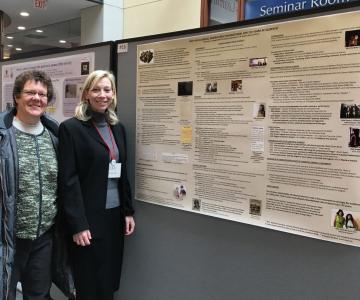

Inquiry@Queen's
9-10 March 2017
Classics had four of its students involved in the annual Inquiry@Queen's Undergraduate Research Conference:
two of our students did presentations, with the other two presenting their research in poster format (see photos below).

Anthea Morgan explored the question of "Why has Classical Drama been Foundational for 172 Years at Queen’s University?". This was the result of a directed research project on the history of classical drama at Queen's. While delving into course calendars, book lists, and newspaper articles in Queen's Archives, Anthea uncovered a wealth of data related to the history of our department and our professors' and students' involvement in the teaching and performance of Greek and Roman drama stretching back to the 1840s. In this poster she suggested why classical drama has always been so important at Queen's.
Anthea is seen here with her proud supervisor, Barbara Reeves.
Alysha Strongman's research focused on cataloguing and identifying coins in "The Diniacopoulos Coin Collection at Queen’s". This is a collection of Greek and Roman coins acquired by the Classics Department and Art Conservation in 2001 for research purposes.
Alysha is seen here with her proud supervisor, Cristiana Zaccagnino.
(photos and text provided by Barbara Reeves)

Kavita Mistry
Photogrammetric Stereoplotting of the Theodosian Palace at the Ancient Site of Stobi, Republic of Macedonia: Reviving a 20th Century Technique for the 21st Century
Faculty Supporter: Prof. George Bevan

The so called “Theodosian Palace” at the site of Stobi in the Republic of Macedonia was built in the 4th century AD and was thought to have been the temporary residence of the Roman emperor Theodosius I when he visited the city in 388 AD. This large structure was richly decorated with coloured marbles and mosaics, many of which have been restored over the years. Unfortunately, the walls that were consolidated prior to 2013 are now suffering serious deterioration and a proposal for this work is now being put together. As a necessary component of this proposal, stone-by-stone top-plans and elevation drawings are crucial to map the current state of these walls.
Manual drawings using tape measures, plumb bobs and graph paper is immensely time consuming for such a large structure. As an alternative to these methods, we have employed Photogrammetric Stereoplotting to produce an accurate map of the Theodosian Palace. Using hundreds of overlapping photos taken of the walls with ground control points surveyed by a total station, highly accurate (<1cm) 3D data was generated using photogrammetric techniques. Individual stereo-models were then mapped in ADAMTech 3DM Analyst. Stereoplotting offers a faster and cost effective solution than manually mapping on site. By using hardware developed for the videogame industry -- active LCD glasses and high refresh-rate monitors -- mapping in 3D allows us to identify the shape and depth of the rocks and structures more accurately and intuitively than on a two-dimensional orthophoto. Once stereoplotted, the drawings are then inputted into AutoCAD Map 3D.
